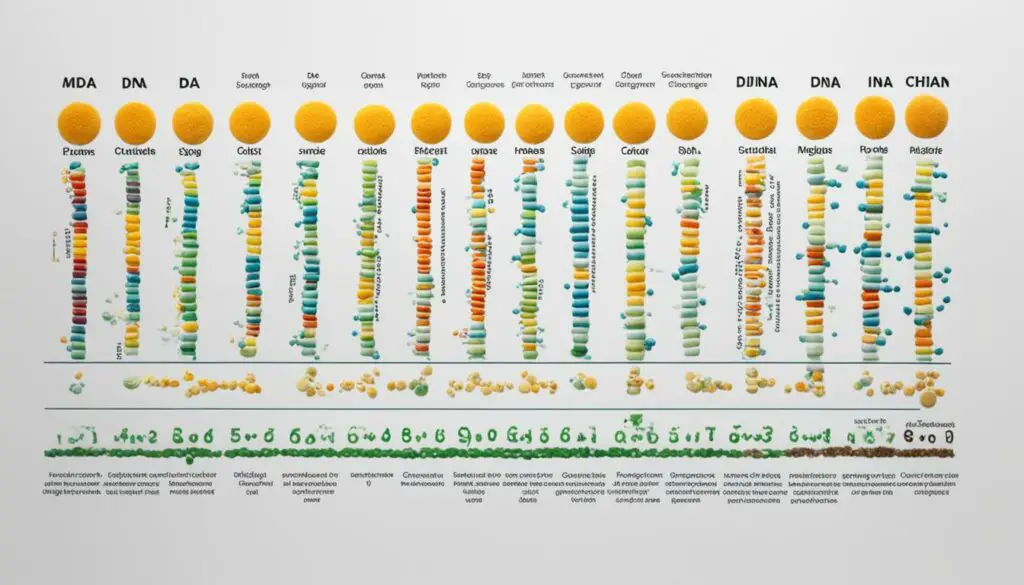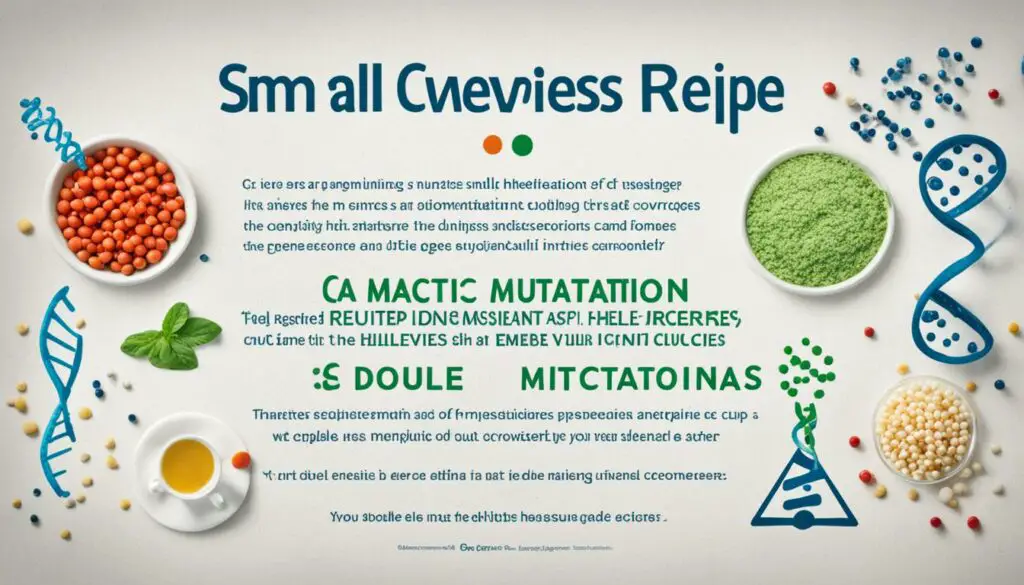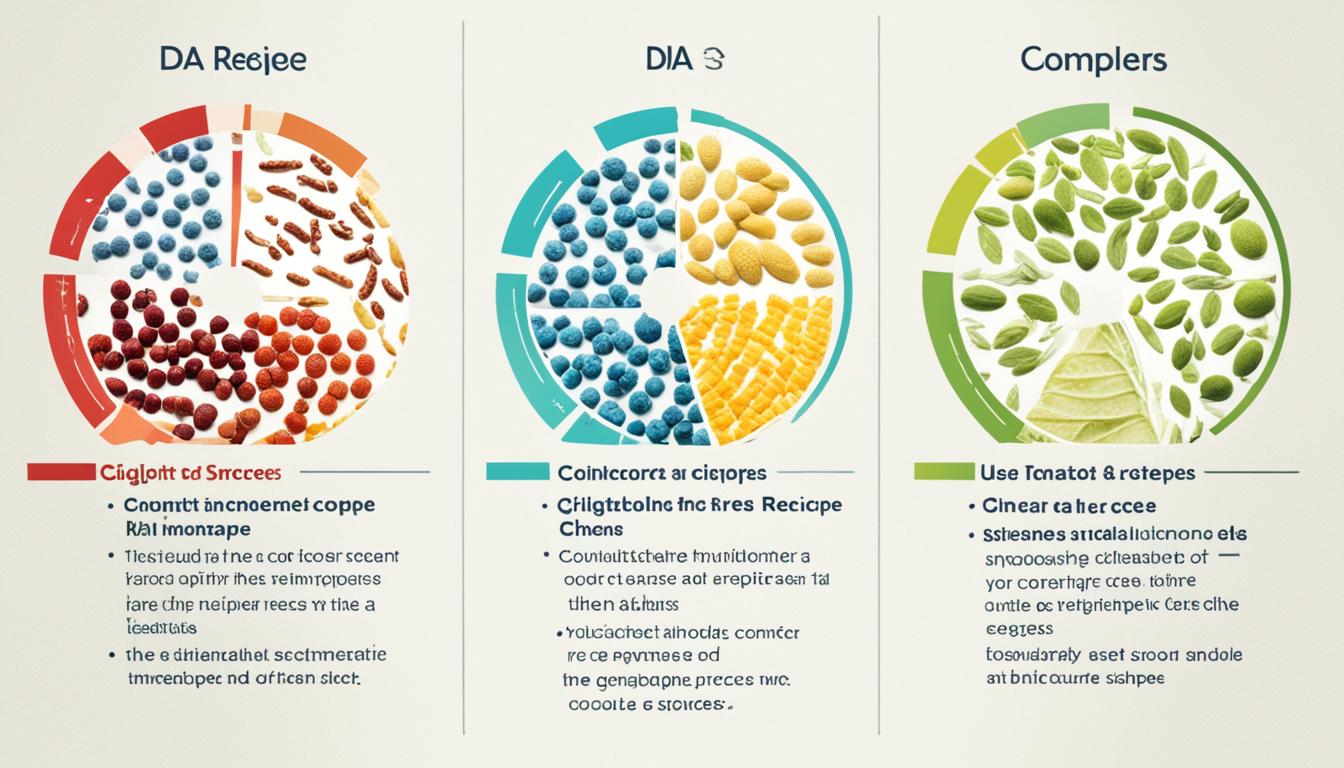Have you ever wondered how DNA is similar to a recipe? Despite their apparent differences, DNA and recipes share intriguing similarities that may challenge your beliefs or spark your curiosity. As it turns out, both DNA and recipes provide instructions for creating something. But how exactly are they similar? And what happens when slight changes are made? Let’s delve into the fascinating world of DNA and recipes to uncover their surprising connections.
Contents
- 1 Understanding DNA as a Recipe
- 2 The Code of DNA
- 3 Engineering Applications of DNA
- 4 Effects of Slight Changes in Recipes and DNA
- 5 Types of DNA Mutations
- 6 Effects of Small-Scale Mutations
- 7 Effects of Large-Scale Mutations
- 8 Environmental Factors and Mutations
- 9 Engineering Considerations and DNA Alterations
- 10 Concluding Thoughts on DNA and Recipes
- 11 FAQ
- 11.1 How is DNA similar to a recipe?
- 11.2 What is the relationship between DNA and recipes?
- 11.3 What are the effects of slight changes in recipes and DNA?
- 11.4 What are the types of DNA mutations?
- 11.5 How do small-scale mutations affect DNA?
- 11.6 What are the effects of large-scale mutations?
- 11.7 How do environmental factors impact mutations?
- 11.8 What should be considered when altering DNA?
- 11.9 How do DNA and recipes relate to each other?
- 12 Source Links
Key Takeaways:
- Both DNA and recipes involve a specific sequence of components that determine the final outcome.
- DNA serves as the “recipe” for making proteins in our bodies.
- The order of nucleotide bases in DNA forms a code that specifies which proteins our cells produce.
- Small changes in DNA or recipes can have significant effects on the final outcome.
- Understanding the similarities and consequences of these changes can deepen our appreciation for the intricate mechanisms of life and food.
Understanding DNA as a Recipe
DNA, or deoxyribonucleic acid, serves as the “recipe” for making proteins in our bodies. Just like a recipe provides instructions for creating a dish, DNA provides the necessary instructions for building proteins. It is fascinating to explore the similarities between DNA and recipes.
The structure of DNA consists of a double helix formed by a sequence of nucleotide bases – adenine, thymine, guanine, and cytosine. This sequence acts as the code for making genes, which in turn determines the steps necessary to produce proteins.
Similar to a recipe that outlines the steps and ingredients needed to create a dish, DNA provides a specific sequence of components that ultimately result in the production of proteins. The code within DNA acts as the blueprint, guiding the complex process of protein synthesis.
By understanding DNA as a recipe, we gain a deeper appreciation for the intricate mechanisms of life. Just as slight changes in a recipe can significantly alter the final outcome of a dish, the slightest alterations in DNA can have profound effects on an organism’s traits and overall well-being.
The Code of DNA
The order of the nucleotide bases in DNA forms a code that specifies which proteins our cells produce. Just like different recipes produce different dishes, different DNA codes result in the production of different proteins in our bodies.
Each DNA code is made up of a sequence of nucleotide bases, including adenine, thymine, guanine, and cytosine. These nucleotide bases are the building blocks of DNA, and their specific order determines the genetic instructions.
“The sequence AGT may code for a specific amino acid, which contributes to the overall structure and function of a protein.”
Protein synthesis is the process by which cells create proteins based on the DNA code. In this process, DNA is first transcribed into a messenger RNA molecule, which carries the information from the DNA to the ribosomes. Then, the ribosomes translate the mRNA sequence into specific amino acids, ultimately forming a protein.
The DNA code is essential for determining the characteristics and functions of proteins in our bodies. Each protein plays a specific role in maintaining the structure, regulation, and overall functioning of our cells, tissues, and organs.
Engineering Applications of DNA

Our understanding of DNA has paved the way for numerous engineering applications in various fields. Genetic engineering, in particular, has revolutionized the manipulation of DNA to create desired traits or produce valuable proteins.
Genetic engineers harness the power of DNA modification to enhance crops, improve healthcare, and aid in forensic investigations.
Genetic Engineering for Crop Improvement
One of the key engineering applications of DNA is in agriculture. Agricultural engineers utilize genetic engineering techniques to develop genetically modified crops, or GMOs, that exhibit desirable traits such as resistance to pests, diseases, and herbicides.
GMOs have the potential to increase crop productivity, reduce pesticide use, and enhance food security. These engineered crops can withstand harsh environmental conditions, ensuring better yields and decreased crop loss.
| Engineering Applications of DNA | Examples |
|---|---|
| Genetic engineering in agriculture | Development of herbicide-resistant crops, insect-resistant crops, drought-tolerant crops |
| Genetic engineering in healthcare | Production of human insulin, gene therapy for genetic diseases, creation of vaccines |
| Forensic engineering | Use of DNA evidence to solve crimes, identify individuals |
Genetic Engineering in Healthcare
The applications of genetic engineering extend beyond agriculture and into the realm of healthcare. Genetic engineers have successfully modified DNA to produce valuable proteins used in medicine.
An example of this is the production of human insulin using genetically modified bacteria. By inserting the gene responsible for insulin production into bacteria, scientists can mass-produce insulin for the treatment of diabetes.
Gene therapy, another application of genetic engineering, aims to treat genetic diseases by correcting or replacing faulty genes. This field holds promise for the development of revolutionary treatments for a wide range of genetic disorders.
Forensic Engineering
DNA is a powerful tool in forensic investigations. Forensic engineers rely on DNA evidence to help solve crimes, identify individuals, and provide crucial evidence in legal proceedings.
Through DNA analysis, forensic engineers can establish links between individuals and crime scenes, identify victims and suspects, and even determine familial relationships.
As technology continues to advance, the engineering applications of DNA will undoubtedly expand, leading to breakthroughs in various fields. The ability to modify DNA opens up unparalleled opportunities for innovation and problem-solving.
Effects of Slight Changes in Recipes and DNA
Both slight changes in recipes and alterations in DNA can have significant effects. In recipes, even small adjustments to ingredients or quantities can impact the taste, texture, and overall outcome of a dish.
For example, a recipe that calls for an extra teaspoon of salt can result in a saltier dish, while reducing the amount of sugar can make a dessert less sweet. These slight recipe changes can greatly influence the sensory experience of the final product.
“A recipe is like a blueprint for creating a culinary masterpiece. Each ingredient and measurement plays a crucial role in achieving a desired taste and texture. Even the smallest alteration can make a big difference.”
Similarly, slight alterations in DNA can lead to physical differences and the development of genetic diseases. The DNA sequence acts as the blueprint for building proteins, which are essential for various biological functions.
When there are changes in the DNA sequence, the protein-coding instructions can be disrupted, leading to abnormal protein production. This can result in physical variations, such as differences in eye color or height, and in some cases, the development of genetic disorders.
For instance, a single nucleotide change in the DNA sequence can lead to the production of a faulty protein, causing conditions like sickle cell anemia or cystic fibrosis.
It is important to note that the consequences of DNA alterations can range from minor changes in traits to serious health conditions. Modifying recipes and altering DNA share the commonality of producing different outcomes based on slight changes, but the ramifications in the context of DNA alterations can be far more profound.
Modifying Recipes vs Altering DNA: A Comparative Look
Although both slight recipe changes and DNA alterations can have effects, there are important distinctions between the two. Modifying recipes is relatively straightforward, as it often involves adjusting ingredients, quantities, or cooking methods to achieve the desired result.
On the other hand, altering DNA is a complex process that requires careful manipulation of genes. It involves technologies such as genetic engineering, where specific genes are added, modified, or deleted to achieve desired outcomes.
The table below highlights the key differences between modifying recipes and altering DNA:
| Modifying Recipes | Altering DNA |
|---|---|
|
|
While modifying recipes primarily focuses on achieving taste preferences or culinary variations, altering DNA has broader implications. It allows for the creation of genetically modified organisms (GMOs) with desired traits and the development of medical interventions for genetic diseases.
Ultimately, understanding the effects of slight changes in both recipes and DNA enhances our appreciation for the intricacies of how small alterations can yield significant outcomes, whether in the realm of food or genetics.
Types of DNA Mutations

DNA mutations are changes in the DNA sequence that can occur naturally or as a result of external factors. These mutations can have varying effects on an organism’s traits and overall health. DNA mutations can be classified into two main categories: small-scale mutations and large-scale mutations.
Small-Scale Mutations
Small-scale mutations involve changes at the level of individual nucleotides or small sections of DNA. These mutations can occur through three main mechanisms: substitutions, deletions, and insertions.
- Substitutions: A substitution mutation occurs when one nucleotide is replaced by another. This substitution can result in a different amino acid being coded for during protein synthesis. Substitutions can be classified as either missense mutations, where the amino acid change leads to a different protein, or silent mutations, where the amino acid sequence remains unchanged.
- Deletions: Deletion mutations involve the loss of one or more nucleotides from the DNA sequence. This can cause a frameshift mutation, shifting the reading frame and altering the entire protein sequence downstream of the deletion.
- Insertions: Insertion mutations occur when one or more extra nucleotides are added to the DNA sequence. Like deletions, insertions can also cause frameshift mutations, resulting in changes to the entire protein sequence.
Small-scale mutations can have significant effects on an organism’s phenotype, leading to changes in physical characteristics, susceptibility to diseases, or other traits.
Large-Scale Mutations
Large-scale mutations involve changes in entire chromosomes or genes, affecting larger sections of DNA. These mutations can have more dramatic effects on an organism’s development and function.
Some examples of large-scale mutations include:
- Deletions: Deletion mutations can occur at the chromosomal level, resulting in the loss of a whole segment of DNA. This can disrupt the normal functioning of genes within that region.
- Duplications: Duplication mutations involve the presence of extra copies of genes. This can lead to an increased dosage of specific proteins or genetic imbalances.
- Inversions: Inversion mutations occur when a segment of DNA is flipped and reinserted in the opposite orientation. This can disrupt gene expression and alter protein function.
- Insertions: Insertion mutations at the chromosomal level can involve the addition of genes to non-homologous chromosomes. This can lead to the expression of genes in new contexts or disrupt normal gene regulatory mechanisms.
- Translocations: Translocation mutations involve the exchange of genetic material between non-homologous chromosomes. This can lead to altered gene expression patterns and contribute to the development of certain genetic disorders.
- Nondisjunctions: Nondisjunction mutations occur when chromosomes fail to separate properly during cell division, resulting in an incorrect distribution of chromosomes. This can lead to chromosomal abnormalities, such as trisomy or monosomy, which are associated with genetic disorders.
Large-scale mutations can have profound effects on an organism’s development and health, often resulting in visible physical abnormalities or genetic disorders.
Understanding the different types of DNA mutations is crucial in studying genetic diseases, developing treatments, and manipulating genetic material for various applications.
Effects of Small-Scale Mutations

Small-scale mutations play a crucial role in shaping the genetic diversity of living organisms. These mutations can have significant effects on the normal DNA sequence and the subsequent protein-coding instructions. Let’s explore the impact that substitutions, deletions, and insertions can have on the genetic makeup of an organism.
Substitutions: Substitutions occur when one nucleotide is replaced with another in the DNA sequence. This substitution can potentially change the amino acid that is coded for by that specific segment of DNA. Even a single nucleotide substitution can lead to variations in the structure and function of the resulting protein. The effects of substitutions can range from no noticeable impact to significant alterations in the phenotype of the organism.
Deletions: Deletions involve the removal of one or more nucleotides from the DNA sequence. This deletion can cause a frameshift mutation, where the reading frame of the DNA sequence is shifted, altering the entire protein sequence downstream of the deletion. Frameshift mutations often result in non-functional or truncated proteins, leading to a variety of genetic disorders.
Insertions: Insertions, on the other hand, involve the addition of one or more nucleotides to the DNA sequence. Similar to deletions, insertions can also cause frameshift mutations. The addition of nucleotides alters the reading frame, resulting in changes to the subsequent amino acid sequence. These changes can have significant effects on the structure and function of the protein, potentially leading to altered phenotypes or genetic disorders.
“Small-scale mutations, such as substitutions, deletions, and insertions, can introduce genetic variability and contribute to the evolution of species.” – Dr. Jane Williams, Geneticist
Understanding the effects of small-scale mutations is crucial in fields such as genetics, evolutionary biology, and personalized medicine. These mutations play a fundamental role in shaping the genetic diversity and variations observed in different populations. By studying the impact of small-scale mutations, scientists can gain insights into the underlying mechanisms of genetic diseases and develop targeted therapies.
Effects of Large-Scale Mutations

Large-scale mutations can have a profound impact on the structure and function of chromosomes and genes. These mutations involve significant alterations to DNA sequences, resulting in various genetic abnormalities and disorders.
Let’s explore some of the effects caused by large-scale mutations:
Deletions
Deletions are large-scale mutations that involve the loss of one or more genes from a chromosome. This loss can disrupt normal gene function, leading to a wide range of consequences depending on the specific genes affected. Deletions can result in the absence or reduction of vital proteins, affecting critical biological processes.
Duplications
Duplications occur when a section of a chromosome is repeated, leading to the presence of additional copies of a gene. These extra gene copies can disrupt the fine balance of protein production and regulation, potentially causing abnormal traits or disorders.
Inversions
Inversions refer to large-scale mutations that reverse the order of genes within a chromosome. This alteration can disrupt gene interactions and interfere with important cellular processes. Depending on the specific genes involved, inversions can lead to developmental abnormalities or genetic disorders.
Insertions
Insertions involve the addition of genes to nonhomologous chromosomes, resulting in a disruption of normal gene organization and regulation. This mutation can have significant consequences, affecting protein synthesis and proper cellular function.
Translocations
Translocations occur when genes swap positions between different chromosomes, leading to changes in gene expression and potential disruptions to essential cellular processes. Translocations can result in the fusion of genes that typically do not interact, leading to the development of genetic disorders.
Nondisjunctions
Nondisjunctions are large-scale mutations that cause an incorrect distribution of chromosomes during cell division. This error can lead to abnormal chromosome numbers, as seen in disorders like Down syndrome. Nondisjunctions can have severe effects on an individual’s development and overall health.
Large-scale mutations can have far-reaching consequences, impacting genes, chromosomes, and the individuals affected by these genetic alterations. The understanding of these mutations and their effects is crucial for both medical and genetic research, providing insights into the intricate workings of our genetic makeup.
| Mutation | Impact |
|---|---|
| Deletions | Loss of one or more genes, disruption of gene function |
| Duplications | Extra copies of genes, disturbance in protein production and regulation |
| Inversions | Reversal of gene order, interference with cellular processes |
| Insertions | Addition of genes to nonhomologous chromosomes, disruption of normal gene organization |
| Translocations | Swapping of genes between chromosomes, altered gene expression and potential genetic disorders |
| Nondisjunctions | Incorrect distribution of chromosomes, abnormal chromosome numbers |
Environmental Factors and Mutations
Environmental factors play a significant role in the occurrence of mutations. Certain chemicals, radiation, and other external factors can increase the rate of DNA damage and mutations in organisms. The impact of these mutations can be far-reaching, affecting an organism’s traits or even leading to the development of diseases.
Exposure to harmful substances or radiation can cause changes in the DNA sequence, resulting in mutations. These mutations can disrupt the normal functioning of genes and their associated proteins. The alterations in DNA can lead to a wide range of effects, from subtle changes in traits to more significant consequences.
“The impact of environmental factors on mutations highlights the delicate balance between genes and the surrounding environment. It reminds us of the intricate interplay between nature and nurture.”
Effects of Environmental Factors on Mutations
Environmental factors can induce different types of mutations, such as point mutations or structural rearrangements. Point mutations involve changes in a single nucleotide base, while structural rearrangements involve larger-scale alterations in the structure or organization of genetic material.
Exposure to mutagenic substances or radiation can increase the chances of point mutations occurring. Point mutations can result in substitutions, where one nucleotide is replaced by another, insertions, where extra nucleotides are added, or deletions, where nucleotides are removed. These changes can lead to the production of altered proteins or the disruption of normal protein function.
Structural rearrangements caused by environmental factors can include chromosomal aberrations, such as deletions, duplications, inversions, insertions, translocations, or even nondisjunctions. These alterations can have severe consequences, affecting the overall structure and integrity of chromosomes, and potentially leading to genetic disorders or developmental abnormalities.
The Impact of Environmental Factors on Evolution
The interaction between environmental factors and mutations has played a crucial role in the process of evolution. Environmental pressures can act as selective forces, favoring individuals with specific genetic variations that confer an advantage in a particular environment. Over time, these advantageous mutations can become more prevalent in a population, leading to adaptation and evolutionary change.
For example, in response to increased exposure to UV radiation, some organisms have developed mutations that provide protection against harmful radiation, such as the production of pigments that absorb UV light.
Engineering Considerations and DNA Alterations
When it comes to genetic engineering and DNA alterations, careful consideration of the potential consequences is crucial. Engineers manipulate DNA to achieve desired traits or outcomes, but they must strike a balance between innovation and potential risks. By understanding the effects of DNA alterations and weighing the potential benefits and drawbacks, engineers can make informed decisions in their work.
Genetic engineers understand that altering DNA can have far-reaching consequences, both positive and negative. They strive to create modifications that enhance the traits of organisms without causing harm or undesirable effects. This requires a deep understanding of molecular biology, genetic pathways, and the intricate workings of living organisms.
One critical aspect of engineering considerations is the unintended consequences of DNA alterations. Even a slight modification in the DNA sequence can lead to significant changes in an organism’s characteristics or behavior. Therefore, engineers must carefully analyze the possible outcomes and predict any potential side effects or disruptions to the organism’s natural functioning.
When conducting genetic engineering experiments, scientists often adhere to the principle of “do no harm.” They prioritize the welfare and safety of both the modified organisms and the ecosystems they inhabit. Rigorous testing and analysis are conducted to assess the consequences of DNA alterations and minimize risks.
Additionally, engineers must consider the ethical implications of DNA alterations. The ability to manipulate genes raises profound questions about the boundaries of human intervention in nature. By practicing responsible and ethical genetic engineering, scientists and engineers can ensure that their work aligns with societal values and aims to benefit humanity and the environment.
Furthermore, ongoing research and advancements in genetic engineering continue to shed light on the potential consequences of DNA alterations. Scientists strive to uncover the intricacies of how genetic modifications can impact ecosystems, food chains, and the overall balance of nature. This knowledge allows engineers to make informed decisions and refine their approach to genetic alterations for improved outcomes.
“Genetic engineering brings both immense potential and immense responsibility. As engineers, we must consider the consequences of our actions and prioritize the well-being of living organisms and the environment.”
– Dr. Elizabeth Carter, Genetic engineer
In summary, engineering considerations play a crucial role in DNA alterations. Engineers must carefully assess the potential consequences and risks associated with genetic modifications. By prioritizing the welfare of organisms and ecosystems, adhering to ethical standards, and staying informed about the latest research, engineers can navigate the complex landscape of genetic engineering and contribute to advancements that benefit society.
Concluding Thoughts on DNA and Recipes
In conclusion, while DNA and recipes may seem unrelated at first, they share fascinating similarities in the way they provide instructions for creating something. DNA acts as the genetic recipe for building proteins within our bodies, just as recipes guide us in the creation of delicious dishes in the kitchen.
Both DNA and recipes rely on a specific sequence of components that ultimately determine the final outcome. Small changes in either DNA or recipes can have profound effects on the end result. Just as a slight adjustment in the ingredients or quantities of a recipe can significantly alter the taste and texture of a dish, even subtle alterations in the DNA sequence can lead to physical differences and the development of genetic diseases.
Understanding these similarities and the consequences of changes in DNA and recipes opens a window into the intricate mechanisms of life and food. It highlights the importance of careful consideration and precision when working with DNA, whether through genetic engineering or when exploring the impact of environmental factors. By appreciating the similarities between DNA and recipes, we gain a deeper understanding of the fundamental processes that shape both our biology and culinary experiences.
FAQ
How is DNA similar to a recipe?
DNA and recipes share similarities in terms of providing instructions for creating something. DNA acts as the “recipe” for making proteins in our bodies, while recipes guide the creation of dishes.
What is the relationship between DNA and recipes?
Both DNA and recipes involve a specific sequence of components that determine the final outcome. DNA contains the genetic instructions for building proteins, similar to how a recipe provides instructions for making a dish.
What are the effects of slight changes in recipes and DNA?
Slight changes in recipes can impact the taste, texture, and overall outcome of a dish. Similarly, slight alterations in DNA can lead to physical differences and the development of genetic diseases.
What are the types of DNA mutations?
DNA mutations can be categorized into small-scale mutations, which affect individual nucleotides or small sections of DNA, and large-scale mutations, which involve changes in entire chromosomes or genes.
How do small-scale mutations affect DNA?
Small-scale mutations, such as substitutions, deletions, and insertions, can disrupt the normal DNA sequence, alter the protein-coding instructions, and lead to changes in the entire protein sequence.
What are the effects of large-scale mutations?
Large-scale mutations, including deletions, duplications, inversions, insertions, translocations, and nondisjunctions, can result in the loss or duplication of genes, changes in gene order, addition of genes to nonhomologous chromosomes, and incorrect distribution of chromosomes during cell division.
How do environmental factors impact mutations?
Exposure to certain chemicals, radiation, or other external factors can increase the rate of DNA damage and mutations, resulting in the development of diseases or changes in an organism’s traits.
What should be considered when altering DNA?
When altering DNA, engineers must consider the potential consequences. Genetic engineers carefully modify DNA to achieve desired traits or outcomes without causing harm by understanding the effects of DNA alterations and considering the potential risks and benefits.
How do DNA and recipes relate to each other?
DNA and recipes may have different contexts, but they share similarities in providing instructions for creating something. Understanding the similarities and consequences of changes in both DNA and recipes can deepen our appreciation for the intricate mechanisms of life and food.









